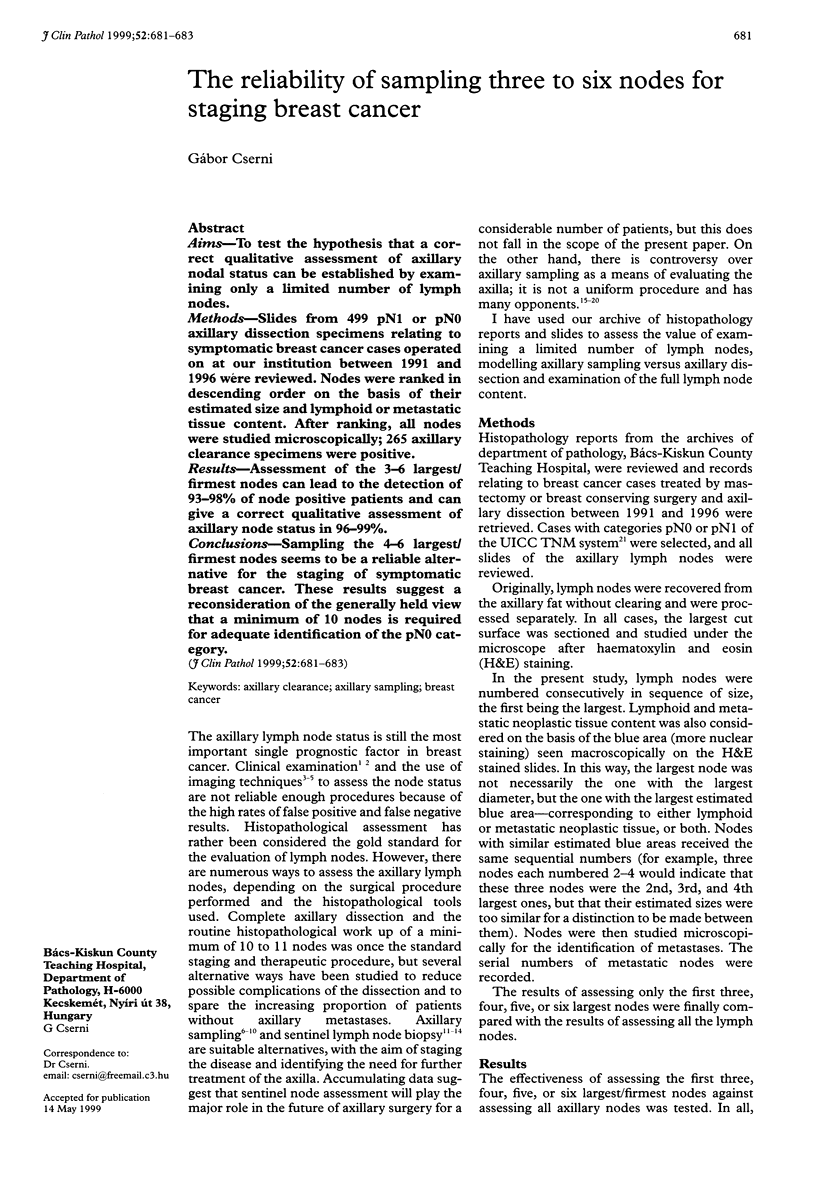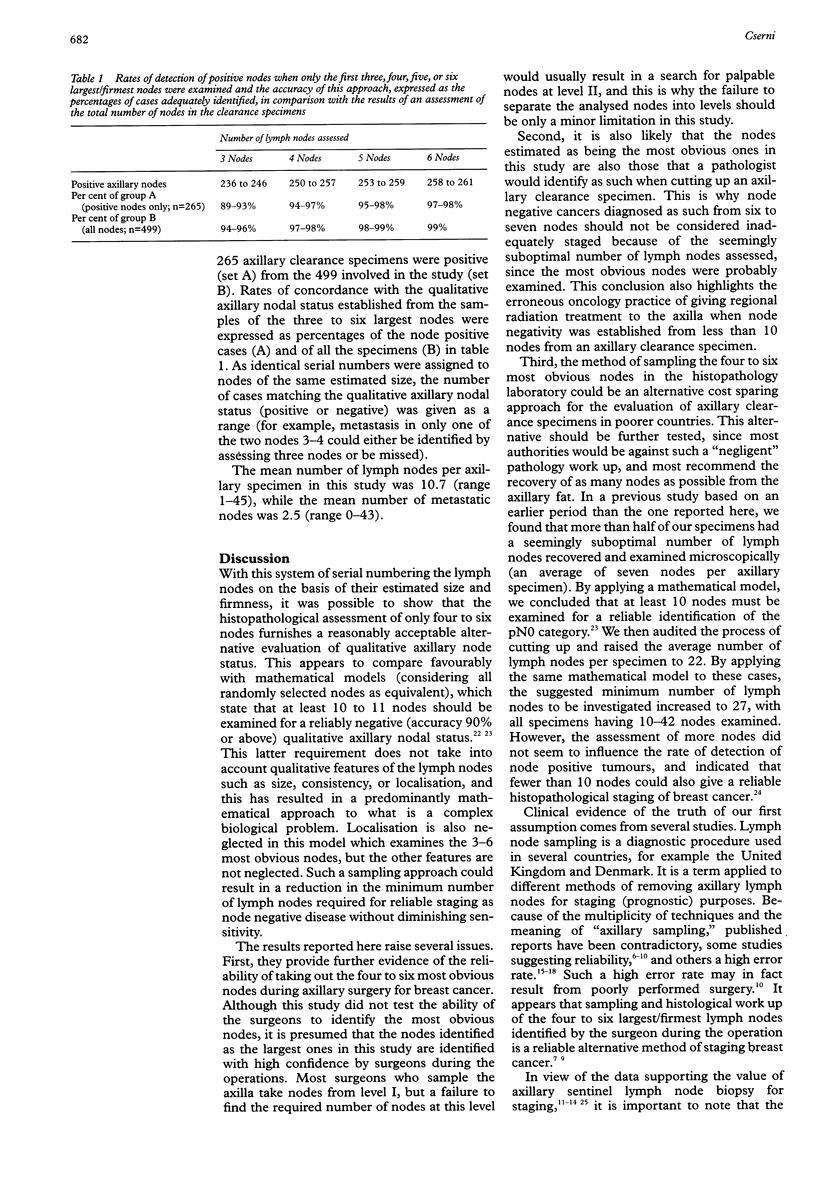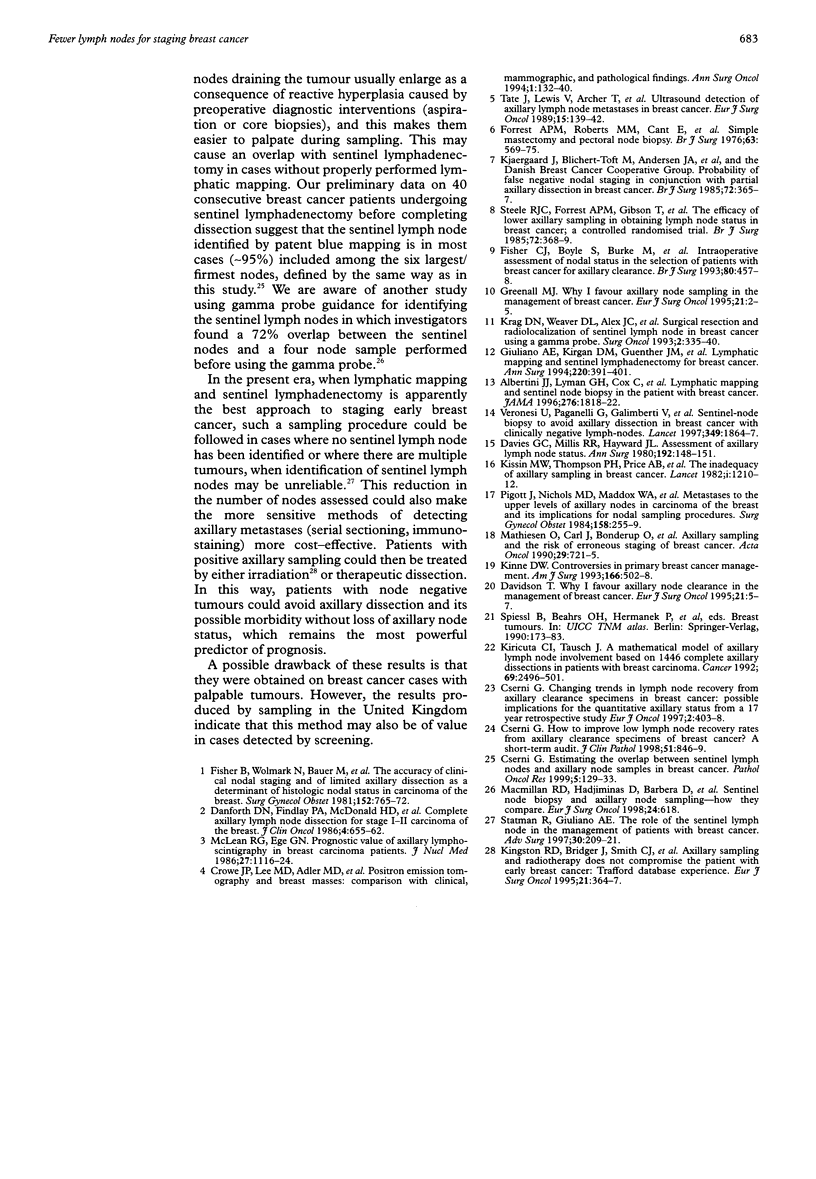Abstract
AIMS: To test the hypothesis that a correct qualitative assessment of axillary nodal status can be established by examining only a limited number of lymph nodes. METHODS: Slides from 499 pN1 or pN0 axillary dissection specimens relating to symptomatic breast cancer cases operated on at our institution between 1991 and 1996 were reviewed. Nodes were ranked in descending order on the basis of their estimated size and lymphoid or metastatic tissue content. After ranking, all nodes were studied microscopically; 265 axillary clearance specimens were positive. RESULTS: Assessment of the 3-6 largest/firmest nodes can lead to the detection of 93-98% of node positive patients and can give a correct qualitative assessment of axillary node status in 96-99%. CONCLUSIONS: Sampling the 4-6 largest/firmest nodes seems to be a reliable alternative for the staging of symptomatic breast cancer. These results suggest a reconsideration of the generally held view that a minimum of 10 nodes is required for adequate identification of the pN0 category.
Full text
PDF


Selected References
These references are in PubMed. This may not be the complete list of references from this article.
- Albertini J. J., Lyman G. H., Cox C., Yeatman T., Balducci L., Ku N., Shivers S., Berman C., Wells K., Rapaport D. Lymphatic mapping and sentinel node biopsy in the patient with breast cancer. JAMA. 1996 Dec 11;276(22):1818–1822. [PubMed] [Google Scholar]
- Crowe J. P., Jr, Adler L. P., Shenk R. R., Sunshine J. Positron emission tomography and breast masses: comparison with clinical, mammographic, and pathological findings. Ann Surg Oncol. 1994 Mar;1(2):132–140. doi: 10.1007/BF02303557. [DOI] [PubMed] [Google Scholar]
- Cserni G. Estimating the overlap between sentinel lymph nodes and axillary node samples in breast cancer. Pathol Oncol Res. 1999;5(2):129–133. doi: 10.1053/paor.1999.0174. [DOI] [PubMed] [Google Scholar]
- Cserni G. How to improve low lymph node recovery rates from axillary clearance specimens of breast cancer. A short-term audit. J Clin Pathol. 1998 Nov;51(11):846–849. doi: 10.1136/jcp.51.11.846. [DOI] [PMC free article] [PubMed] [Google Scholar]
- Danforth D. N., Jr, Findlay P. A., McDonald H. D., Lippman M. E., Reichert C. M., d'Angelo T., Gorrell C. R., Gerber N. L., Lichter A. S., Rosenberg S. A. Complete axillary lymph node dissection for stage I-II carcinoma of the breast. J Clin Oncol. 1986 May;4(5):655–662. doi: 10.1200/JCO.1986.4.5.655. [DOI] [PubMed] [Google Scholar]
- Davidson T. How should the axilla be treated in breast cancer? Why I favour axillary node clearance in the management of breast cancer. Eur J Surg Oncol. 1995 Feb;21(1):5–7. doi: 10.1016/s0748-7983(05)80057-5. [DOI] [PubMed] [Google Scholar]
- Davies G. C., Millis R. R., Hayward J. L. Assessment of axillary lymph node status. Ann Surg. 1980 Aug;192(2):148–151. doi: 10.1097/00000658-198008000-00002. [DOI] [PMC free article] [PubMed] [Google Scholar]
- Fisher B., Wolmark N., Bauer M., Redmond C., Gebhardt M. The accuracy of clinical nodal staging and of limited axillary dissection as a determinant of histologic nodal status in carcinoma of the breast. Surg Gynecol Obstet. 1981 Jun;152(6):765–772. [PubMed] [Google Scholar]
- Fisher C. J., Boyle S., Burke M., Price A. B. Intraoperative assessment of nodal status in the selection of patients with breast cancer for axillary clearance. Br J Surg. 1993 Apr;80(4):457–458. doi: 10.1002/bjs.1800800416. [DOI] [PubMed] [Google Scholar]
- Forrest A. P., Roberts M. M., Cant E., Shivas A. Simple mastectomy and pectoral node biopsy. Br J Surg. 1976 Aug;63(8):569–575. doi: 10.1002/bjs.1800630802. [DOI] [PubMed] [Google Scholar]
- Giuliano A. E., Kirgan D. M., Guenther J. M., Morton D. L. Lymphatic mapping and sentinel lymphadenectomy for breast cancer. Ann Surg. 1994 Sep;220(3):391–401. doi: 10.1097/00000658-199409000-00015. [DOI] [PMC free article] [PubMed] [Google Scholar]
- Greenall M. J. How should the axilla be treated in breast cancer? Why I favour axillary node sampling in the management of breast cancer. Eur J Surg Oncol. 1995 Feb;21(1):2–5. doi: 10.1016/s0748-7983(05)80056-3. [DOI] [PubMed] [Google Scholar]
- Kingston R. D., Bridger J., Smith C. J., Jeacock J., Robinson C. Axillary sampling and radiotherapy does not compromise the patient with early breast cancer: Trafford database experience. Eur J Surg Oncol. 1995 Aug;21(4):364–367. doi: 10.1016/s0748-7983(95)92351-9. [DOI] [PubMed] [Google Scholar]
- Kinne D. W. Controversies in primary breast cancer management. Am J Surg. 1993 Nov;166(5):502–508. doi: 10.1016/s0002-9610(05)81144-4. [DOI] [PubMed] [Google Scholar]
- Kiricuta C. I., Tausch J. A mathematical model of axillary lymph node involvement based on 1446 complete axillary dissections in patients with breast carcinoma. Cancer. 1992 May 15;69(10):2496–2501. doi: 10.1002/1097-0142(19920515)69:10<2496::aid-cncr2820691018>3.0.co;2-t. [DOI] [PubMed] [Google Scholar]
- Kissin M. W., Thompson E. M., Price A. B., Slavin G., Kark A. E. The inadequacy of axillary sampling in breast cancer. Lancet. 1982 May 29;1(8283):1210–1212. doi: 10.1016/s0140-6736(82)92337-6. [DOI] [PubMed] [Google Scholar]
- Krag D. N., Weaver D. L., Alex J. C., Fairbank J. T. Surgical resection and radiolocalization of the sentinel lymph node in breast cancer using a gamma probe. Surg Oncol. 1993 Dec;2(6):335–340. doi: 10.1016/0960-7404(93)90064-6. [DOI] [PubMed] [Google Scholar]
- Mathiesen O., Carl J., Bonderup O., Panduro J. Axillary sampling and the risk of erroneous staging of breast cancer. An analysis of 960 consecutive patients. Acta Oncol. 1990;29(6):721–725. doi: 10.3109/02841869009092990. [DOI] [PubMed] [Google Scholar]
- Pigott J., Nichols R., Maddox W. A., Balch C. M. Metastases to the upper levels of the axillary nodes in carcinoma of the breast and its implications for nodal sampling procedures. Surg Gynecol Obstet. 1984 Mar;158(3):255–259. [PubMed] [Google Scholar]
- Statman R., Giuliano A. E. The role of the sentinel lymph node in the management of patients with breast cancer. Adv Surg. 1996;30:209–221. [PubMed] [Google Scholar]
- Steele R. J., Forrest A. P., Gibson T., Stewart H. J., Chetty U. The efficacy of lower axillary sampling in obtaining lymph node status in breast cancer: a controlled randomized trial. Br J Surg. 1985 May;72(5):368–369. doi: 10.1002/bjs.1800720512. [DOI] [PubMed] [Google Scholar]
- Tate J. J., Lewis V., Archer T., Guyer P. G., Royle G. T., Taylor I. Ultrasound detection of axillary lymph node metastases in breast cancer. Eur J Surg Oncol. 1989 Apr;15(2):139–141. [PubMed] [Google Scholar]
- Veronesi U., Paganelli G., Galimberti V., Viale G., Zurrida S., Bedoni M., Costa A., de Cicco C., Geraghty J. G., Luini A. Sentinel-node biopsy to avoid axillary dissection in breast cancer with clinically negative lymph-nodes. Lancet. 1997 Jun 28;349(9069):1864–1867. doi: 10.1016/S0140-6736(97)01004-0. [DOI] [PubMed] [Google Scholar]


